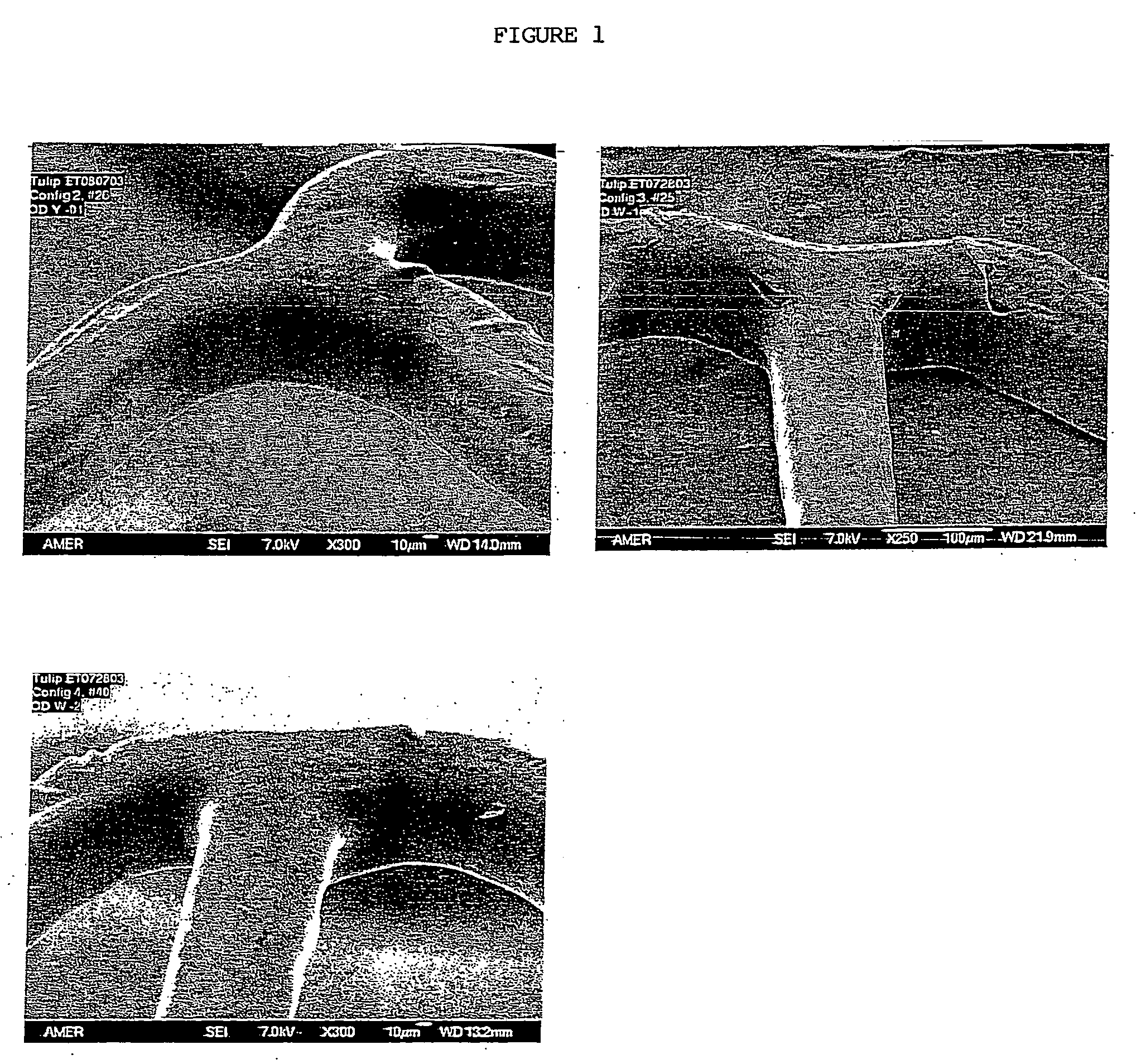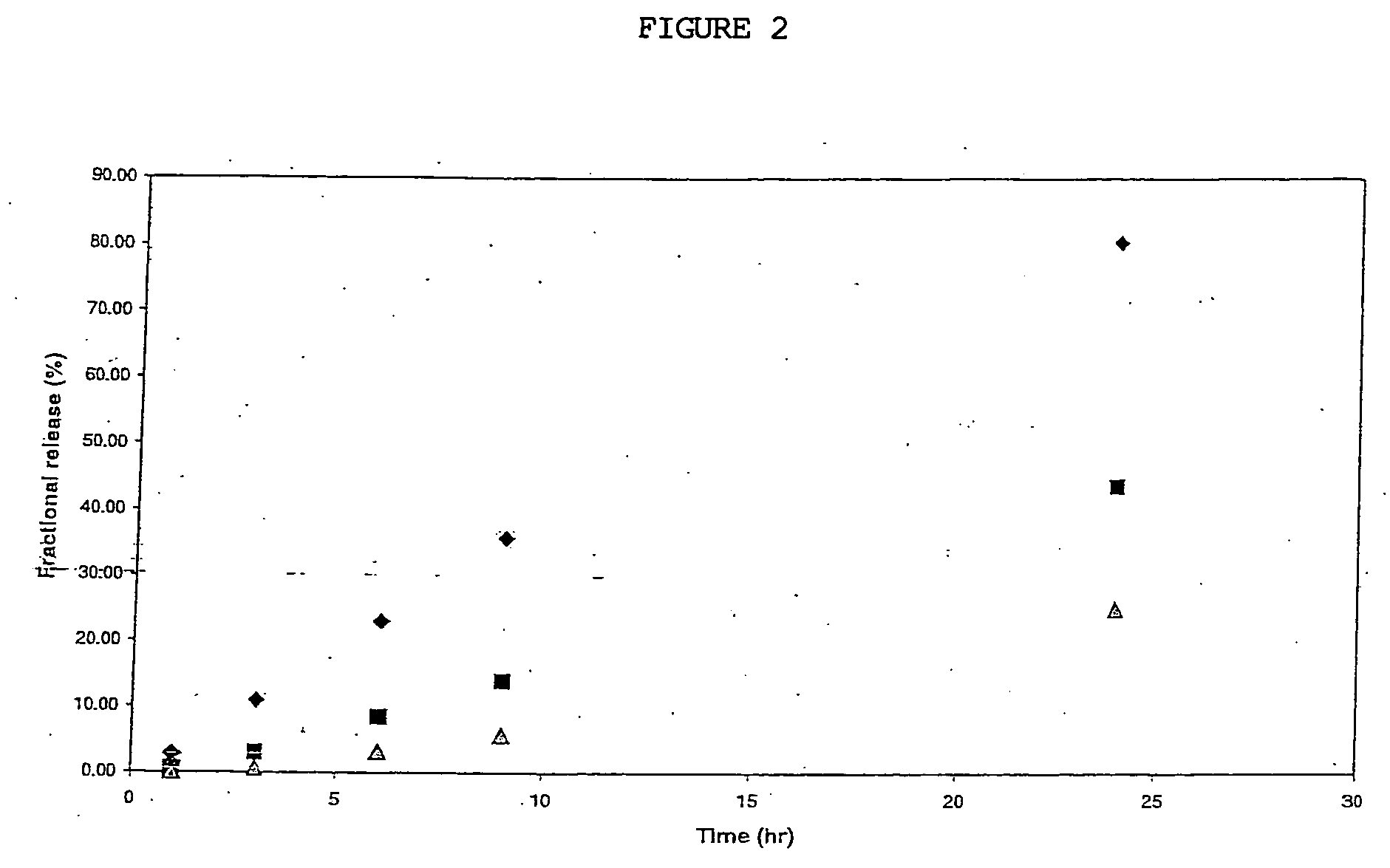Poly(ester amide) filler blends for modulation of coating properties
a technology of filler blends and esters, applied in the field of poly(ester amide) (pea) polymer blends, can solve the problems of reducing release rate control, reducing shelf life stability, and affecting the stability of the product, so as to improve the stability, the release rate of the drug, and the mechanical characteristics
- Summary
- Abstract
- Description
- Claims
- Application Information
AI Technical Summary
Benefits of technology
Problems solved by technology
Method used
Image
Examples
example 1
Study of Stents Coated with the Combination of Poly(Ester Amide) and PolyActive™
[0038] Vision 12 mm small stents (available from Guidant Corporation) are coated according to the following configurations:
[0039] Configuration 1
[0040] Primer layer: 100 μg PolyActive™, from a 2% PolyActive™ (300PEGT55PBT45) solution in a solvent mixture of 1,1,2-trichloroethane and chloroform (80 / 20) (w / w), and baked at 50° C. for 1 hour;
[0041] Drug layer: 120 μg everolimus, coated from a 2% drug solution dissolved in a solvent mixture of acetone / xylene (60 / 40) (w / w), baked at 50° C. for 1 hour;
[0042] PEA release rate control layer: 100 μg PEA, coated from a 2% PEA solution in ethanol; baked at 50° C. for 1 hour;
[0043] PolyActive™ biobeneficial layer: 200 μg PolyActive™, coated from a 2% PolyActive™ (300PEGT55PBT45) solution in a solvent mixture of 1,1,2-trichloroethane and chloroform (80 / 20) (w / w), and baked at 50° C. for 1 hour.
[0044] Configuration 2
[0045] Primer layer: 100 μg PolyActive™, from...
example 2
Stents Coated with PEA-TEMPO
[0055] A first composition is prepared by mixing the following components:
(a) about 2.0% (w / w) of the polymer PEA-TEMPO
(b) the balance, ethyl alcohol
[0056] The first composition can be applied onto the surface of bare 12 mm small VISION™ stent (Guidant Corp.). The coating can be sprayed and dried to form a primer layer. A spray coater can be used having a 0.014 round nozzle maintained at ambient temperature with a feed pressure 2.5 psi (0.17 atm) and an atomization pressure of about 15 psi (1.02 atm). About 20 μg of the coating can be applied per one spray pass. Between spray passes, the stent can be dried for about 10 seconds in a flowing air stream at about 50° C. About 110 μg of wet coating can be applied. The stents can be baked at about 50° C. for about one hour, yielding a primer layer composed of approximately 100 μg of PEA-TEMPO.
example 3
Stents Coated with PEA-TEMPO and Poly(Imino Carbonate)
[0057] A second composition can be prepared by mixing the following components:
[0058] (a) about 1.8% (w / w) of the polymer of PEA-TEMPO;
[0059] (b) about 0.2% (w / w) of poly(imino carbonate)
[0060] (b) about 0.5% (w / w) of everolimus; and
[0061] (c) the balance, a solvent mixture of ethyl alcohol and dimethylformamide (80 / 20) (w / w)
[0062] The second composition can be applied onto the dried primer layer to form the drug-polymer layer, using the same spraying technique and equipment used for applying the primer layer. About 300 μg of wet coating can be applied followed by drying and baking at about 60° C. for about 2 hours, yielding a dry drug-polymer layer having solids content of about 275 μg.
PUM
| Property | Measurement | Unit |
|---|---|---|
| molecular weight | aaaaa | aaaaa |
| weight-average molecular weight | aaaaa | aaaaa |
| atomization pressure | aaaaa | aaaaa |
Abstract
Description
Claims
Application Information
 Login to View More
Login to View More - R&D
- Intellectual Property
- Life Sciences
- Materials
- Tech Scout
- Unparalleled Data Quality
- Higher Quality Content
- 60% Fewer Hallucinations
Browse by: Latest US Patents, China's latest patents, Technical Efficacy Thesaurus, Application Domain, Technology Topic, Popular Technical Reports.
© 2025 PatSnap. All rights reserved.Legal|Privacy policy|Modern Slavery Act Transparency Statement|Sitemap|About US| Contact US: help@patsnap.com



